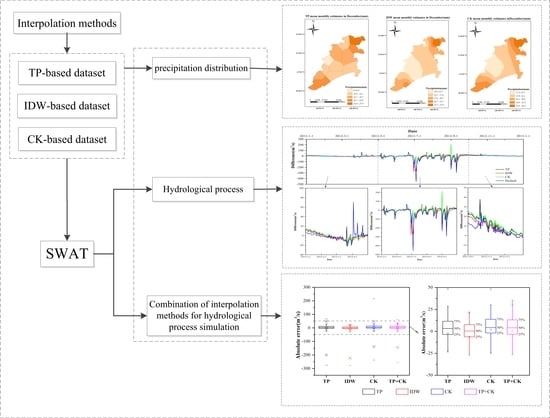Performance Assessment of Spatial Interpolation of Precipitation for Hydrological Process Simulation in the Three Gorges Basin
Abstract
:1. Introduction
2. Materials and Methods
2.1. Study Area
2.2. Precipitation Data
2.3. Interpolation Schemes
2.3.1. Thiessen Polygon
2.3.2. Inverse Distance Weighting
2.3.3. Co-Kriging
2.4. Combination of Interpolation Methods’ Estimates
2.5. Hydrologic Model
2.5.1. Model Setup
2.5.2. Model Evaluation
3. Results and Discussion
3.1. Analysis of the Spatial Interpolation of Precipitation Distribution
3.2. Analysis of Runoff Process by Spatial Interpolation of Precipitation
3.3. Combination of Interpolation Methods’ Estimates for Runoff Process Simulation
3.3.1. Combining Interpolation Methods’ Estimates
3.3.2. Performance Comparison
4. Conclusions
Acknowledgments
Author Contributions
Conflicts of Interest
References
- Caracciolo, D.; Arnone, E.; Noto, L.V. Influence of spatial precipitation sampling on hydrological response at the catchment scale. J. Hydrol. Eng. 2014, 19, 544–553. [Google Scholar] [CrossRef]
- Szcześniak, M.; Piniewski, M. Improvement of hydrological simulations by applying daily precipitation interpolation schemes in meso-scale catchments. Water 2015, 7, 747–779. [Google Scholar] [CrossRef]
- Cristiano, E.; ten Veldhius, M.-C.; van de Giesen, N. Spatial and temporal variability of rainfall and their effects on hydrological response in urban areas—A review. Hydrol. Earth Syst. Sci. Discuss. 2017, 21, 3859–3878. [Google Scholar] [CrossRef]
- Li, J.; Heap, A.D. A review of comparative studies of spatial interpolation methods in environmental sciences: Performance and impact factors. Ecol. Inform. 2011, 6, 228–241. [Google Scholar] [CrossRef]
- Xu, W.; Zou, Y.; Zhang, G.; Linderman, M. A comparison among spatial interpolation techniques for daily rainfall data in Sichuan province, China. Int. J. Climatol. 2015, 35, 2898–2907. [Google Scholar] [CrossRef]
- Bayat, B.; Zahraie, B.; Taghavi, F.; Nasseri, M. Evaluation of spatial and spatiotemporal estimation methods in simulation of precipitation variability patterns. Theor. Appl. Climatol. 2012, 113, 429–444. [Google Scholar] [CrossRef]
- Ly, S.; Charles, C.; Degré, A. Different methods for spatial interpolation of rainfall data for operational hydrology and hydrological modeling at watershed scale. A review. Biotechnol. Agron. Soc. Environ. 2013, 17, 392–406. [Google Scholar]
- Li, J.; Heap, A.D. Spatial interpolation methods applied in the environmental sciences: A review. Environ. Model. Softw. 2014, 53, 173–189. [Google Scholar] [CrossRef]
- Zareian, M.J.; Eslamian, S.; Safavi, H.R. A modified regionalization weighting approach for climate change impact assessment at watershed scale. Theor. Appl. Climatol. 2014, 122, 497–516. [Google Scholar] [CrossRef]
- Borges, P.D.A.; Franke, J.; da Anunciação, Y.M.T.; Weiss, H.; Bernhofer, C. Comparison of spatial interpolation methods for the estimation of precipitation distribution in distrito Federal, Brazil. Theor. Appl. Climatol. 2015, 123, 335–348. [Google Scholar] [CrossRef]
- Yamamoto, J.K. Correcting the smoothing effect of ordinary kriging estimates. Math. Geol. 2005, 37, 69–94. [Google Scholar] [CrossRef]
- Sinclair, S.; Pegram, G. Combining radar and rain gauge rainfall estimates using conditional merging. Atmos. Sci. Lett. 2005, 6, 19–22. [Google Scholar] [CrossRef]
- Wardhana, A.; Pawitan, H.; Dasanto, B.D. Application of hourly radar-gauge merging method for quantitative precipitation estimates. IOP Conf. Ser. Earth Environ. Sci. 2017, 58, 012033. [Google Scholar] [CrossRef]
- Berndt, C.; Rabiei, E.; Haberlandt, U. Geostatistical merging of rain gauge and radar data for high temporal resolutions and various station density scenarios. J. Hydrol. 2014, 508, 88–101. [Google Scholar] [CrossRef]
- Chowdhury, S.; Sharma, A. Global sea surface temperature forecasts using a pairwise dynamic combination approach. J. Clim. 2011, 24, 1869–1877. [Google Scholar] [CrossRef]
- Goudenhoofdt, E.; Delobbe, L. Evaluation of radar-gauge merging methods for quantitative precipitation estimates. Hydrol. Earth Syst. Sci. 2008, 13, 195–203. [Google Scholar] [CrossRef]
- Hasan, M.M.; Sharma, A.; Johnson, F.; Mariethoz, G.; Seed, A. Merging radar and in situ rainfall measurements: An assessment of different combination algorithms. Water Resour. Res. 2016, 52, 8384–8398. [Google Scholar] [CrossRef]
- Robertson, A.W.; Lall, U.; Zebiak, S.E.; Goddard, L. Improved combination of multiple atmospheric gcm ensembles for seasonal prediction. Mon. Weather Rev. 2003, 132, 2732–2744. [Google Scholar] [CrossRef]
- Krishnamurti, T.N.; Kishtawal, C.M.; Zhang, Z.; Larow, T.; Bachiochi, D.; Williford, E.; Gadgil, S.; Surendran, S. Multimodel ensemble forecasts for weather and seasonal climate. J. Clim. 2000, 13, 4196–4216. [Google Scholar] [CrossRef]
- S̆alek, M. The radar and raingauge merge precipitation estimate of daily rainfall—First results in the Czech Republic. Phys. Chem. Earth Part B Hydrol. Oceans Atmos. 2000, 25, 977–979. [Google Scholar] [CrossRef]
- Hasan, M.M.; Sharma, A.; Mariethoz, G.; Johnson, F.; Seed, A. Improving radar rainfall estimation by merging point rainfall measurements within a model combination framework. Adv. Water Resour. 2016, 97, 205–218. [Google Scholar] [CrossRef]
- Woldemeskel, F.M.; Sivakumar, B.; Sharma, A. Merging gauge and satellite rainfall with specification of associated uncertainty across australia. J. Hydrol. 2013, 499, 167–176. [Google Scholar] [CrossRef]
- Guan, K.; Thompson, S.E.; Harman, C.J.; Basu, N.B.; Rao, P.S.C.; Sivapalan, M.; Packman, A.I.; Kalita, P.K. Spatiotemporal scaling of hydrological and agrochemical export dynamics in a tile-drained midwestern watershed. Water Resour. Res. 2011, 47, W00J02. [Google Scholar] [CrossRef]
- Ye, X.; Zhang, Q.; Viney, N.R. The effect of soil data resolution on hydrological processes modelling in a large humid watershed. Hydrol. Process. 2011, 25, 130–140. [Google Scholar] [CrossRef]
- Clark, M.P.; Nijssen, B.; Lundquist, J.D.; Kavetski, D.; Rupp, D.E.; Woods, R.A.; Freer, J.E.; Gutmann, E.D.; Wood, A.W.; Gochis, D.J.; et al. A unified approach for process-based hydrologic modeling: 2. Model implementation and case studies. Water Resour. Res. 2015, 51, 2515–2542. [Google Scholar] [CrossRef]
- Wang, J.; Hassett, J.M.; Endreny, T.A. An object oriented approach to the description and simulation of watershed scale hydrologic processes. Comput. Geosci. 2005, 31, 425–435. [Google Scholar] [CrossRef]
- Uhlenbrook, S.; Roser, S.; Tilch, N. Hydrological process representation at the meso-scale: The potential of a distributed, conceptual catchment model. J. Hydrol. 2004, 291, 278–296. [Google Scholar] [CrossRef]
- Gitau, M.W.; Chaubey, I. Regionalization of swat model parameters for use in ungauged watersheds. Water 2010, 2, 849–871. [Google Scholar] [CrossRef]
- Chaponnière, A.; Boulet, G.; Chehbouni, A.; Aresmouk, M. Understanding hydrological processes with scarce data in a mountain environment. Hydrol. Process. 2008, 22, 1908–1921. [Google Scholar] [CrossRef] [Green Version]
- Galván, L.; Olías, M.; Izquierdo, T.; Cerón, J.C.; Fernández de Villarán, R. Rainfall estimation in swat: An alternative method to simulate orographic precipitation. J. Hydrol. 2014, 509, 257–265. [Google Scholar] [CrossRef]
- Vu, M.T.; Raghavan, S.V.; Liong, S.Y. Swat use of gridded observations for simulating runoff—A Vietnam River basin study. Hydrol. Earth Syst. Sci. 2012, 16, 2801–2811. [Google Scholar] [CrossRef] [Green Version]
- Wagner, P.D.; Fiener, P.; Wilken, F.; Kumar, S.; Schneider, K. Comparison and evaluation of spatial interpolation schemes for daily rainfall in data scarce regions. J. Hydrol. 2012, 464–465, 388–400. [Google Scholar] [CrossRef]
- Shen, Z.; Chen, L.; Liao, Q.; Liu, R.; Hong, Q. Impact of spatial rainfall variability on hydrology and nonpoint source pollution modeling. J. Hydrol. 2012, 472–473, 205–215. [Google Scholar] [CrossRef]
- Masih, I.; Maskey, S.; Uhlenbrook, S.; Smakhtin, V. Assessing the impact of areal precipitation input on streamflow simulations using the swat model1. JAWRA J. Am. Water Resour. Assoc. 2011, 47, 179–195. [Google Scholar] [CrossRef]
- Di Lazzaro, M.; Zarlenga, A.; Volpi, E. Hydrological effects of within-catchment heterogeneity of drainage density. Adv. Water Resour. 2015, 76, 157–167. [Google Scholar] [CrossRef]
- Tetzlaff, D.; Uhlenbrook, U. Effects of spatial variability of precipitation for process-orientated hydrological modelling: Results from two nested catchments. Hydrol. Earth Syst. Sci. Discuss. 2005, 2, 119–154. [Google Scholar] [CrossRef]
- Yu, Z.; Lu, Q.; Zhu, J.; Yang, C.; Ju, Q.; Yang, T.; Chen, X.; Sudicky, E.A. Spatial and temporal scale effect in simulating hydrologic processes in a watershed. J. Hydrol. Eng. 2014, 19, 99–107. [Google Scholar] [CrossRef]
- Shi, Y.; Xu, G.; Wang, Y.; Engel, B.A.; Peng, H.; Zhang, W.; Cheng, M.; Dai, M. Modelling hydrology and water quality processes in the pengxi river basin of the three gorges reservoir using the soil and water assessment tool. Agric. Water Manag. 2017, 182, 24–38. [Google Scholar] [CrossRef]
- Hui, D.; Yang, Y.; Wang, G.; Wang, L.; Yu, J.; Xu, Z. Evaluation of gridded precipitation data for driving swat model in area upstream of three gorges reservoir. PLoS ONE 2014, 9, e112725. [Google Scholar]
- Thiessen, A.H. Precipitation averages for large areas. Mon. Weather Rev. 1911, 39, 1082. [Google Scholar] [CrossRef]
- Mair, A.; Fares, A. Comparison of rainfall interpolation methods in a mountainous region of a tropical island. J. Hydrol. Eng. 2011, 16, 371–383. [Google Scholar] [CrossRef]
- Kurtzman, D.; Navon, S.; Morin, E. Improving interpolation of daily precipitation for hydrologic modelling: Spatial patterns of preferred interpolators. Hydrol. Process. 2010, 23, 3281–3291. [Google Scholar] [CrossRef]
- Jacquin, A.P.; Soto-Sandoval, J.C. Interpolation of monthly precipitation amounts in mountainous catchments with sparse precipitation networks. Chil. J. Agric. Res. 2013, 73, 406–413. [Google Scholar] [CrossRef]
- Adhikary, S.K.; Yilmaz, A.G.; Muttil, N. Optimal design of rain gauge network in the middle yarra river catchment, australia. Hydrol. Process. 2015, 29, 2582–2599. [Google Scholar] [CrossRef]
- Seo, M.; Yen, H.; Kim, M.-K.; Jeong, J. Transferability of swat models between SWAT2009 and SWAT2012. J. Environ. Qual. 2014, 43, 869–880. [Google Scholar] [CrossRef] [PubMed]
- Vazquez-Amabile, G.G.; Engel, B.A. Fitting of time series models to forecast streamflow and groundwater using simulated data from swat. J. Hydrol. Eng. 2008, 13, 554–562. [Google Scholar] [CrossRef]
- Humphrey, C.P.; Jernigan, J.; Iverson, G.; Serozi, B.; O’Driscoll, M.; Pradhan, S.; Bean, E. Field evaluation of nitrogen treatment by conventional and single-pass sand filter onsite wastewater systems in the north carolina piedmont. Water Air Soil Pollut. 2016, 227, 1–17. [Google Scholar] [CrossRef]
- Feng, Q.; Chaubey, I.; Engel, B.; Cibin, R.; Sudheer, K.P.; Volenec, J. Marginal land suitability for switchgrass, Miscanthus and hybrid poplar in the Upper Mississippi River Basin (UMRB). Environ. Model. Softw. 2017, 93, 356–365. [Google Scholar] [CrossRef]
- China Meteorological Data Sharing Service System. Available online: http://data.cma.cn (accessed on 12 September 2016).
- Ruelland, D.; Ardoin-Bardin, S.; Billen, G.; Servat, E. Sensitivity of a lumped and semi-distributed hydrological model to several methods of rainfall interpolation on a large basin in West Africa. J. Hydrol. 2008, 361, 96–117. [Google Scholar] [CrossRef]
- Adhikary, S.K.; Muttil, N.; Yilmaz, A.G. Cokriging for enhanced spatial interpolation of rainfall in two Australian catchments. Hydrol. Process. 2017, 31, 2143–2161. [Google Scholar] [CrossRef]
- Fatichi, S.; Vivoni, E.R.; Ogden, F.L.; Ivanov, V.Y.; Mirus, B.; Gochis, D.; Downer, C.W.; Camporese, M.; Davison, J.H.; Ebel, B.; et al. An overview of current applications, challenges, and future trends in distributed process-based models in hydrology. J. Hydrol. 2016, 537, 45–60. [Google Scholar] [CrossRef]
- Chen, T.; Ren, L.; Yuan, F.; Yang, X.; Jiang, S.; Tang, T.; Liu, Y.; Zhao, C.; Zhang, L. Comparison of spatial interpolation schemes for rainfall data and application in hydrological modeling. Water 2017, 9, 342. [Google Scholar] [CrossRef]
- Moriasi, D.N.; Arnold, J.G.; Van Liew, M.W.; Bingner, R.L.; Harmel, R.D.; Veith, T.L. Model evaluation guidelines for systematic quantification of accuracy in watershed simulations. Trans. ASABE 2007, 50, 885–900. [Google Scholar] [CrossRef]
- Abo-Monasar, A.; Al-Zahrani, M.A. Estimation of rainfall distribution for the southwestern region of saudi arabia. Hydrol. Sci. J. 2014, 59, 420–431. [Google Scholar] [CrossRef]
- Tobin, K.J.; Bennett, M.E. Temporal analysis of Soil and Water Assessment Tool (SWAT) performance based on remotely sensed precipitation products. Hydrol. Process. 2013, 27, 505–514. [Google Scholar] [CrossRef]
- Feyereisen, G.W.; Strickland, T.C.; Bosch, D.D.; Sullivan, D.G. Evaluation of swat manual calibration and input parameter sensitivity in the little river watershed. Trans. ASABE 2007, 50, 843–855. [Google Scholar] [CrossRef]
- Van Liew, M.W.; Arnold, J.G.; Bosch, D.D. Problems and potential of autocalibrating a hydrologic model. Trans. ASAE 2005, 48, 1025–1040. [Google Scholar] [CrossRef]
- Shirmohammadi, A.; Sheridan, J.M.; Asmussen, L.E. Hydrology of alluvial stream channels in southern coastal plain watersheds. Trans. ASAE 1986, 29, 0135–0142. [Google Scholar] [CrossRef]
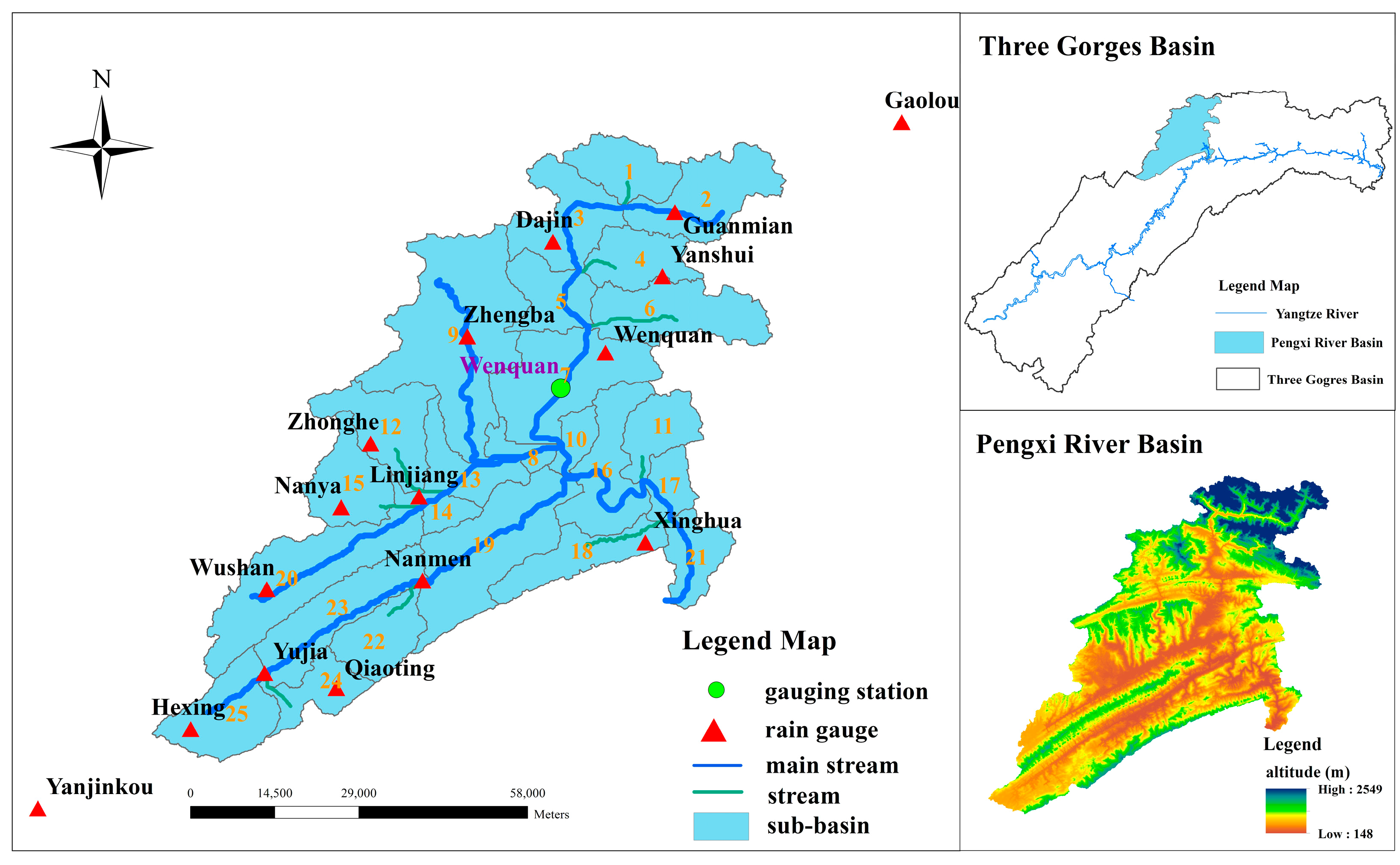
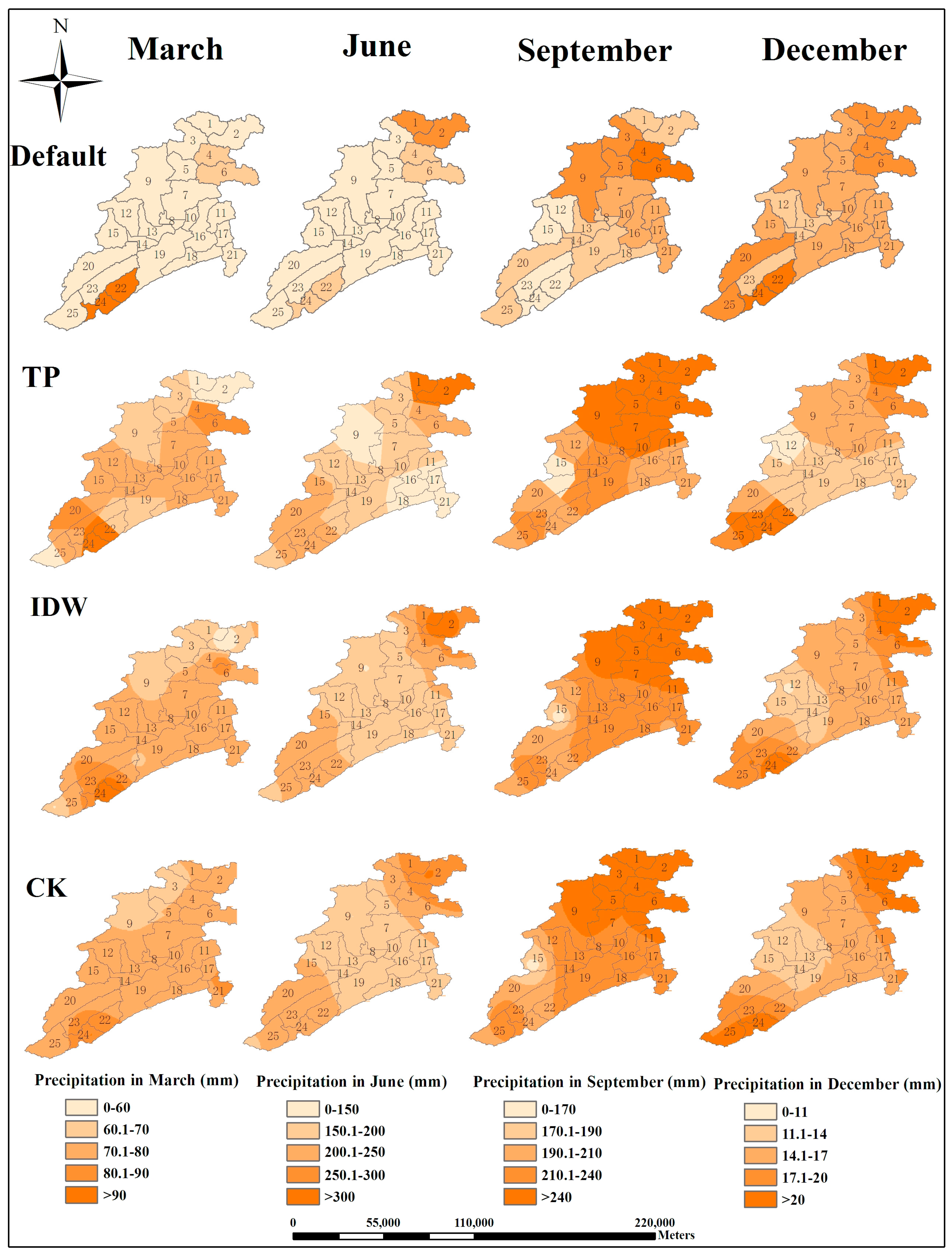
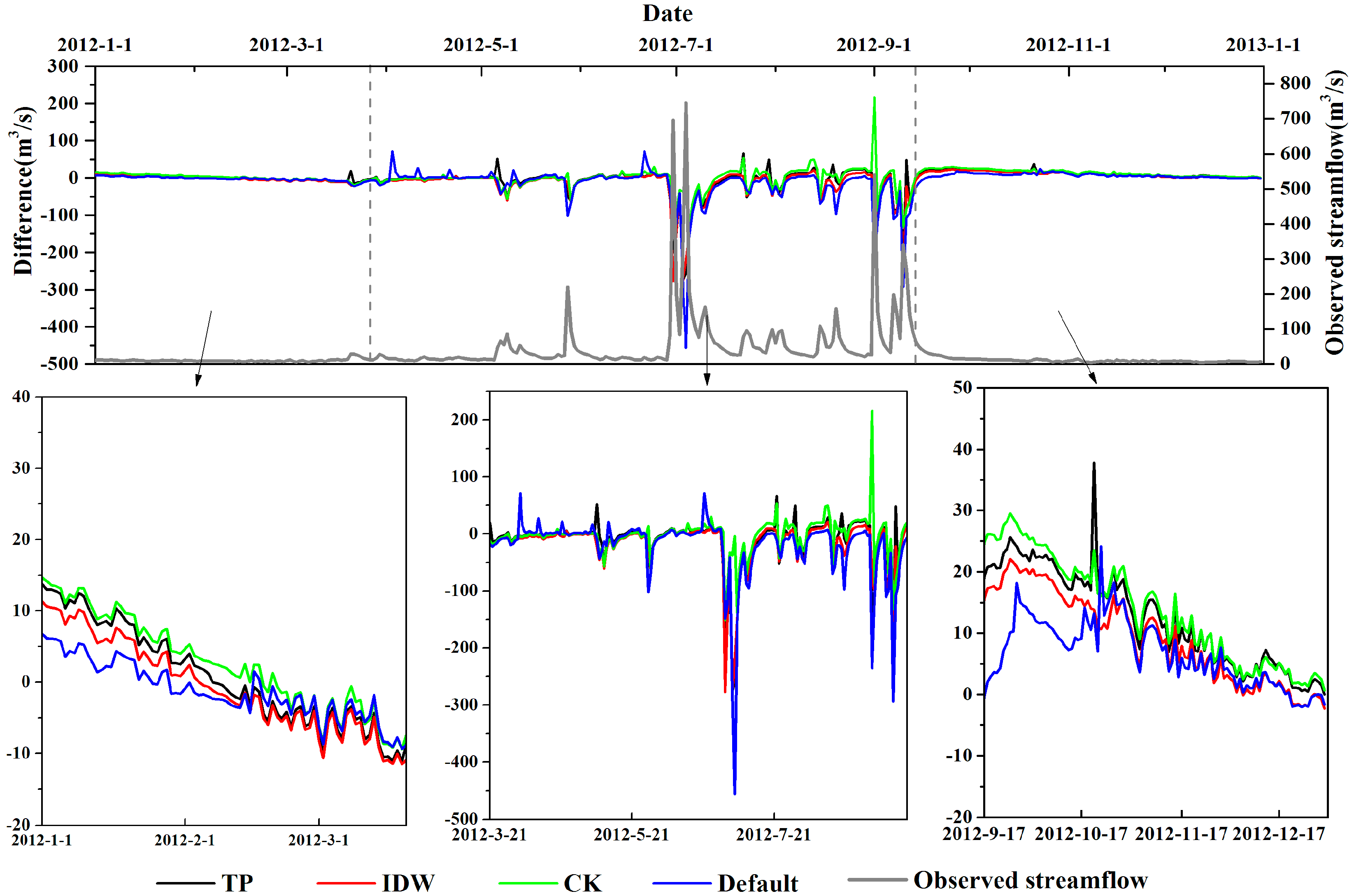
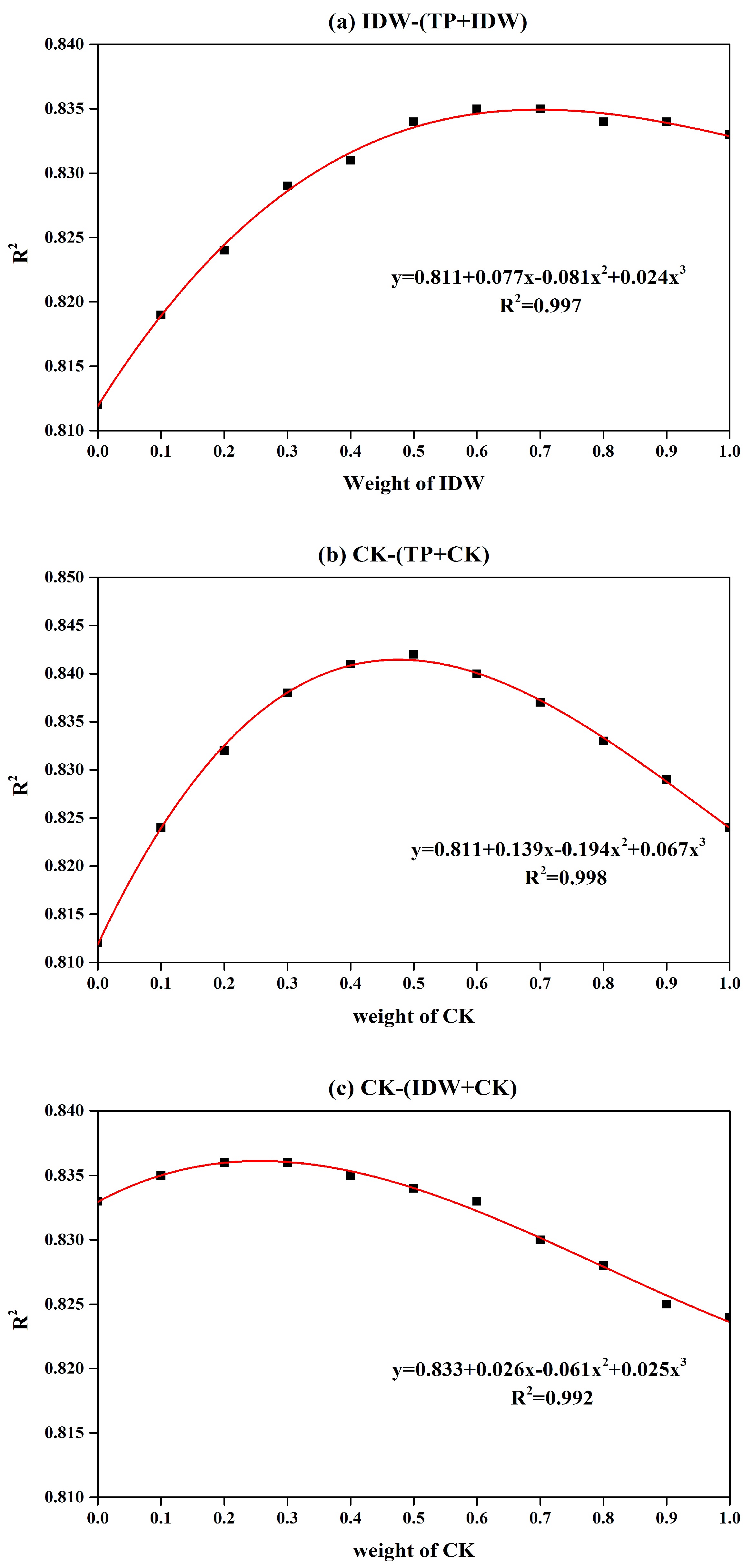
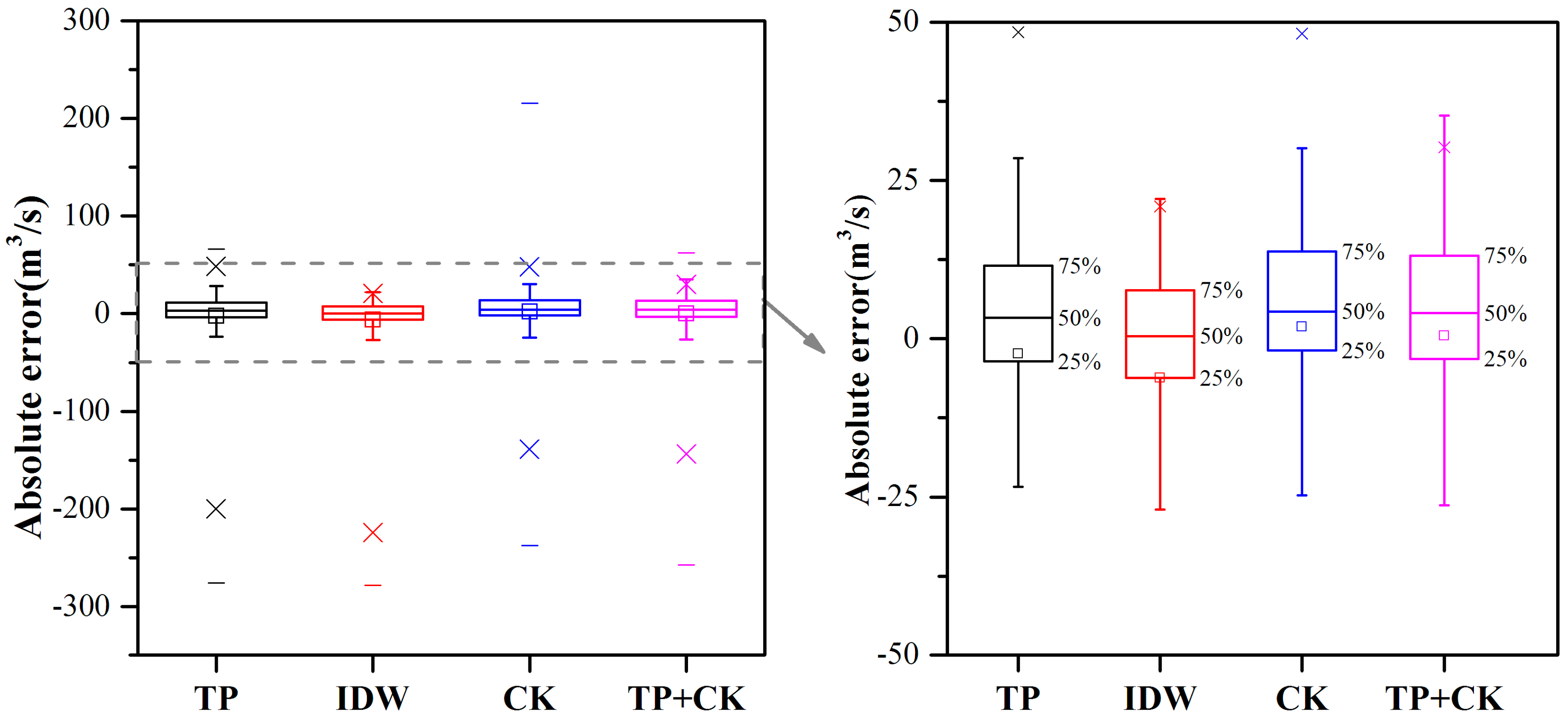
| Gauge | Longitude (° E) | Latitude (° N) | Elevation (m) | Mean Annual Precipitation (mm) |
|---|---|---|---|---|
| Xinghua | 108.63 | 31.01 | 510 | 1040.5 |
| Guanmian | 108.67 | 31.55 | 969 | 1780.1 |
| Dajin | 108.45 | 31.50 | 387 | 1250.2 |
| Yanshui | 108.65 | 31.45 | 1134 | 1516.3 |
| Wenquan | 108.55 | 31.33 | 269 | 1274.6 |
| Wushan | 107.95 | 30.95 | 262 | 1180.1 |
| Nanya | 108.08 | 31.08 | 385 | 1085.5 |
| Linjiang | 108.22 | 31.10 | 204 | 1098.4 |
| Zhonghe | 108.13 | 31.18 | 230 | 1071.8 |
| Zhengba | 108.30 | 31.35 | 401 | 1197.1 |
| Hexing | 107.82 | 30.73 | 418 | 1068.6 |
| Qiaoting | 108.08 | 30.80 | 591 | 1176.1 |
| Yujia | 107.95 | 30.82 | 332 | 1174.3 |
| Nanmen | 108.23 | 30.97 | 127 | 1053.8 |
| Yanjinkou | 107.55 | 30.60 | 444 | 1070.0 |
| Gaolou | 109.08 | 31.60 | 1858 | 1752.5 |
| Sub-Basin | Annual Average Precipitation (mm) | Mean (mm) | SD | CV | |||
|---|---|---|---|---|---|---|---|
| Default | TP | IDW | CK | ||||
| 1 | 1379.4 | 978.4 | 960.0 | 974.6 | 1073.1 | 204.3 | 0.190 |
| 2 | 1379.4 | 1012.8 | 1084.2 | 1193.2 | 1167.4 | 159.6 | 0.137 |
| 3 | 999.3 | 978.4 | 960.0 | 974.6 | 978.1 | 16.2 | 0.017 |
| 4 | 1208.6 | 926.4 | 943.6 | 1037.4 | 1029.0 | 129.2 | 0.126 |
| 5 | 999.3 | 1012.8 | 1084.2 | 1193.2 | 1072.4 | 88.7 | 0.083 |
| 6 | 1208.6 | 1195.6 | 1000.3 | 1074.6 | 1119.8 | 99.9 | 0.089 |
| 7 | 1024.5 | 1195.6 | 1000.3 | 1074.6 | 1073.7 | 86.9 | 0.081 |
| 8 | 871.1 | 1012.8 | 1084.2 | 1193.2 | 1040.3 | 135.0 | 0.130 |
| 9 | 1024.5 | 856.6 | 979.6 | 1045.7 | 976.6 | 84.6 | 0.087 |
| 10 | 1024.5 | 1012.8 | 1084.2 | 1193.2 | 1078.7 | 82.5 | 0.077 |
| 11 | 834.5 | 898.1 | 959.6 | 1065.9 | 939.6 | 98.5 | 0.105 |
| 12 | 871.1 | 959.4 | 976.2 | 1105.4 | 978.0 | 96.6 | 0.099 |
| 13 | 871.1 | 857.0 | 898.7 | 901.4 | 882.0 | 21.6 | 0.024 |
| 14 | 835.7 | 959.4 | 976.2 | 1105.4 | 969.2 | 110.3 | 0.114 |
| 15 | 1024.5 | 946.1 | 921.4 | 968.3 | 965.1 | 43.9 | 0.046 |
| 16 | 1024.5 | 1208.5 | 1104.1 | 1299.6 | 1159.2 | 120.1 | 0.104 |
| 17 | 826.8 | 1245.5 | 1057.9 | 1284.1 | 1103.6 | 209.2 | 0.190 |
| 18 | 826.8 | 1012.8 | 1084.2 | 1193.2 | 1029.2 | 153.9 | 0.150 |
| 19 | 965.3 | 1245.5 | 1057.9 | 1284.1 | 1138.2 | 151.8 | 0.133 |
| 20 | 1024.5 | 1012.8 | 1084.2 | 1193.2 | 1078.7 | 82.5 | 0.077 |
| 21 | 944.8 | 1383.8 | 1016.8 | 1096.1 | 1110.4 | 192.4 | 0.173 |
| 22 | 806.9 | 1208.5 | 1104.1 | 1299.6 | 1104.8 | 214.0 | 0.194 |
| 23 | 944.8 | 1383.8 | 1016.8 | 1096.1 | 1110.4 | 192.4 | 0.173 |
| 24 | 872.1 | 867.7 | 1056.0 | 1173.7 | 992.4 | 149.3 | 0.151 |
| 25 | 959.3 | 1195.6 | 1000.3 | 1074.6 | 1057.4 | 103.7 | 0.098 |
| Method | NSE | R2 | RMSE |
|---|---|---|---|
| Default | 0.64 | 0.76 | 42.85 |
| TP | 0.75 | 0.81 | 35.29 |
| IDW | 0.76 | 0.83 | 35.06 |
| CK | 0.82 | 0.82 | 29.89 |
| Method | First Period | Second Period | Third Period | |||||||||
|---|---|---|---|---|---|---|---|---|---|---|---|---|
| MAE | NSE | R2 | RMSE | MAE | NSE | R2 | RMSE | MAE | NSE | R2 | RMSE | |
| (mm) | (mm) | (mm) | (mm) | (mm) | (mm) | |||||||
| Default | 3.54 | −4.36 | 0.14 | 4.2 | 26.88 | 0.59 | 0.75 | 60.6 | 6.92 | −7.13 | 0.56 | 8.6 |
| TP | 6.19 | −14.6 | 0.13 | 7.2 | 22.7 | 0.73 | 0.81 | 48.8 | 12.58 | −24.05 | 0.59 | 14.8 |
| IDW | 5.62 | −11.68 | 0.12 | 6.5 | 22.09 | 0.74 | 0.83 | 48.1 | 9.56 | −14.85 | 0.72 | 11.8 |
| CK | 5.97 | −14.57 | 0.1 | 7.2 | 20.12 | 0.82 | 0.83 | 40.5 | 13.78 | −28.67 | 0.74 | 16.1 |
| Method | TP | IDW | CK |
|---|---|---|---|
| TP | 1 | 0.89 | 0.83 |
| IDW | — | 1 | 0.96 |
| CK | — | — | 1 |
© 2017 by the authors. Licensee MDPI, Basel, Switzerland. This article is an open access article distributed under the terms and conditions of the Creative Commons Attribution (CC BY) license (http://creativecommons.org/licenses/by/4.0/).
Share and Cite
Cheng, M.; Wang, Y.; Engel, B.; Zhang, W.; Peng, H.; Chen, X.; Xia, H. Performance Assessment of Spatial Interpolation of Precipitation for Hydrological Process Simulation in the Three Gorges Basin. Water 2017, 9, 838. https://doi.org/10.3390/w9110838
Cheng M, Wang Y, Engel B, Zhang W, Peng H, Chen X, Xia H. Performance Assessment of Spatial Interpolation of Precipitation for Hydrological Process Simulation in the Three Gorges Basin. Water. 2017; 9(11):838. https://doi.org/10.3390/w9110838
Chicago/Turabian StyleCheng, Meiling, Yonggui Wang, Bernard Engel, Wanshun Zhang, Hong Peng, Xiaomin Chen, and Han Xia. 2017. "Performance Assessment of Spatial Interpolation of Precipitation for Hydrological Process Simulation in the Three Gorges Basin" Water 9, no. 11: 838. https://doi.org/10.3390/w9110838




